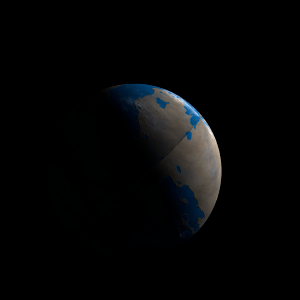|
|
Space Astro
|
Info for exoplanet "Shimaa-joru"
| Scientific (actual) data |
|---|
| Name | HD 184010 b |
| Planet status | Confirmed |
| Mass sini | 0.3 |
| Orbital period | 484.4 |
| Semi major axis | 0.937 |
| Orbit eccentricity | 0.037 |
| Discovered | 2022 |
| Updated | 2022-09-21 |
| Omega | 122.6 |
| Tperi | 2454730 |
| K | 7.7 |
| Publication | Published in a refereed paper |
| Detection type | Radial Velocity |
| Mass measurement type | Radial Velocity |
| Star name | HD 184010 |
| Right ascension | 292.84° |
| Declination | 26.62° |
| Mag v | 5.9 |
| Star distance | 61.37 |
| Star metallicity | -0.17 |
| Star mass | 1.35 |
| Star radius | 4.86 |
| Star sp type | K0III-IV D |
| Star age | 2.76 |
| Star temperature | 4971 |
| Wikipedia article | HD 184010 b |
Back
| |
| Fictional info (?) |
|---|
| Suggested name | Shimaa-joru |
| Planet type | Cold planet |
| Having almost no atmosphere to retain heat, it has surface temperatures that vary diurnally more than on any other planet in its solar system, ranging from 95°K (-178°C) at night to 385°K (112°C) during the day across the equatorial regions.
It is radically different from Earth in other respects. It has the densest atmosphere of all the cold planets, consisting mostly of hydrogen peroxide. |
| Atmosphere | Hydrogen peroxide | 68% |
| Nitric oxide | 20% |
| Carbon dioxide | 12% |
| Atmospheric pressure | 9 bar |
 |
| No known satellites |
| Google search for Shimaa-joru |
|
Website by Joachim Michaelis
|
|
|
|